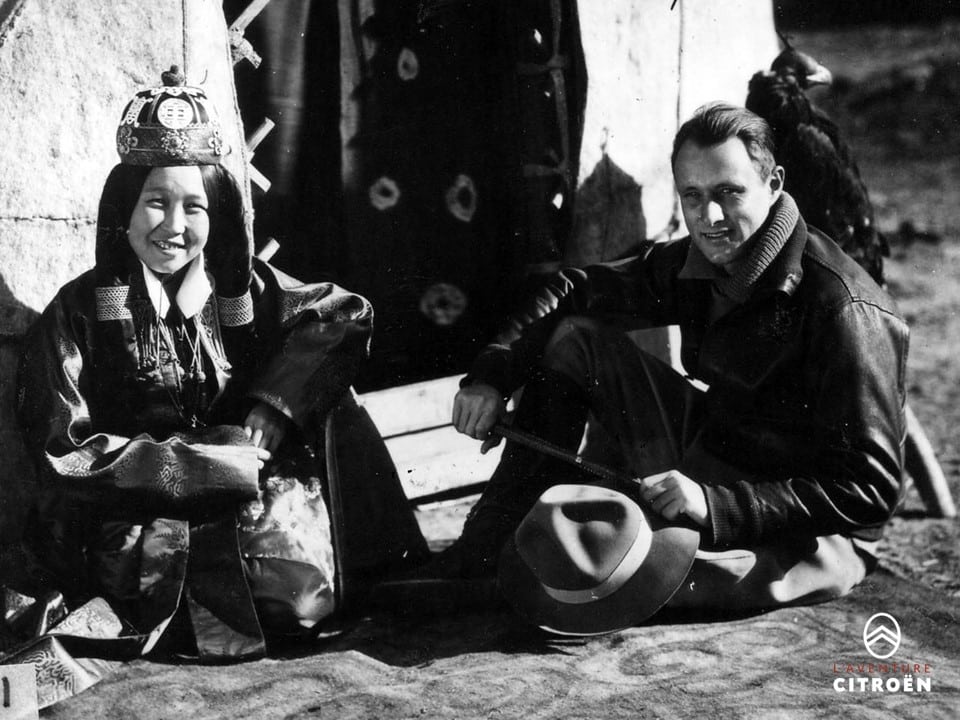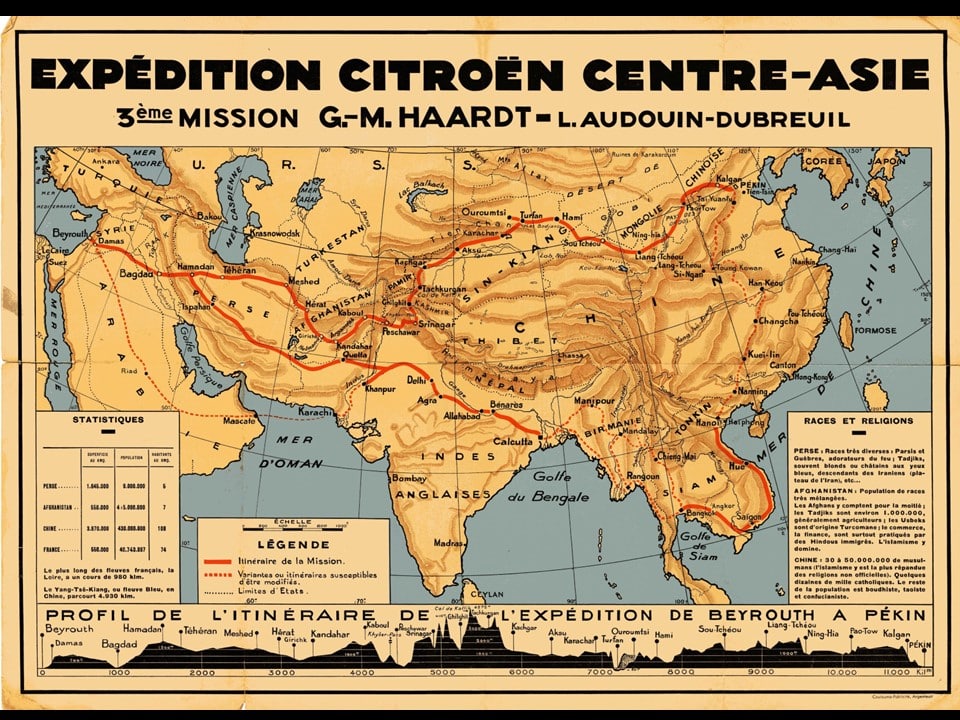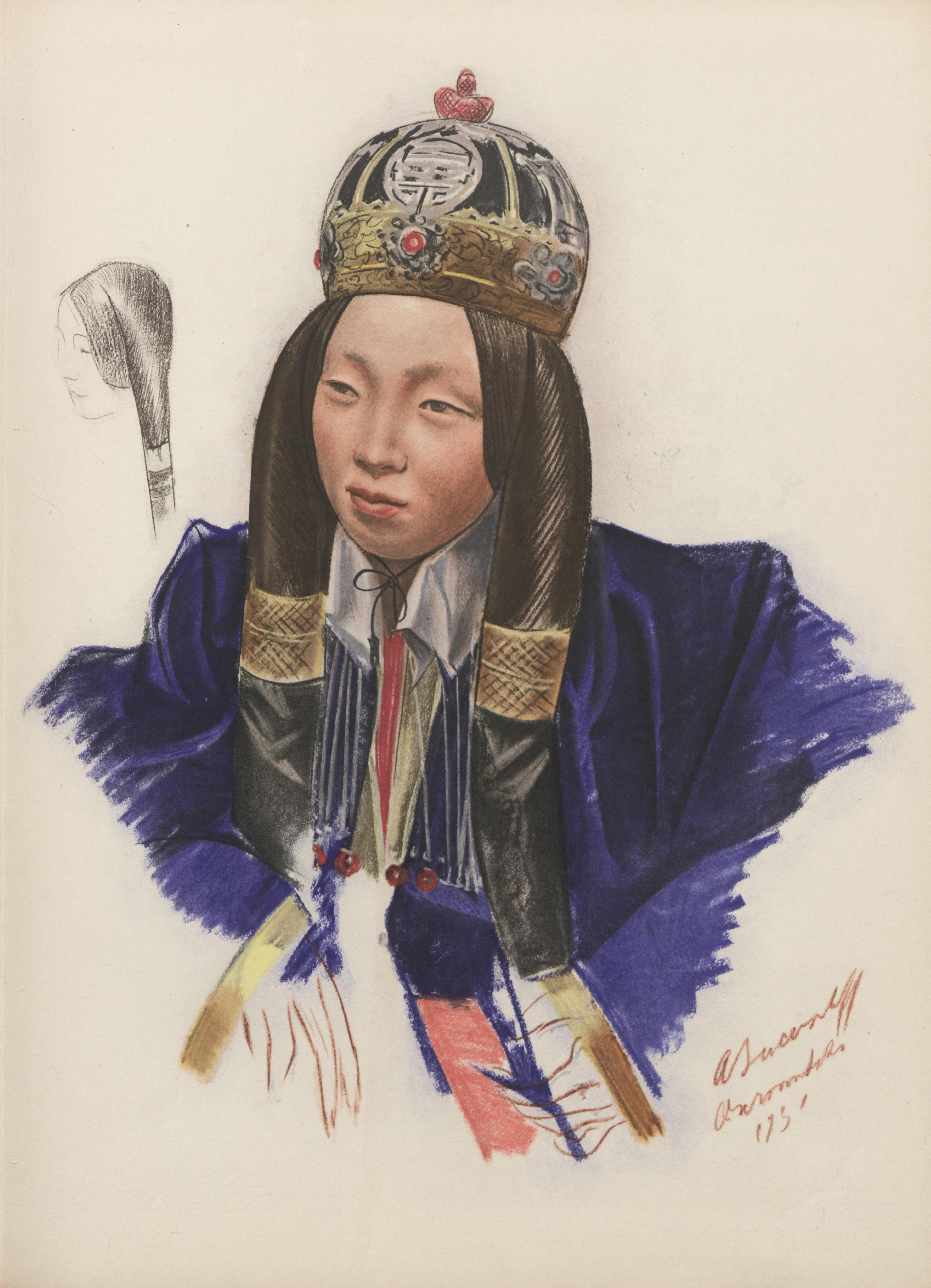
La Princesse et les Citroën / The Princess and Citroën
Découvrez la rencontre d'une Princesse avec des Citroën...
Discover the tale of a Princess meeting Citroën...
La Croisière Jaune, qui se déroule du 4 avril 1931 au 12 février 1932, connue également sous le nom de « Mission Centre-Asie » ou encore « Troisième mission G.M. Haardt – Audouin-Dubreuil », est l’un des raids automobiles organisés par André Citroën. Il s’agit de rallier Beyrouth à Pékin avec des autochenilles avec à bord des mécaniciens, des photographes et cinéastes, et des scientifiques. 13 000 km de voyage avec des découvertes, des témoignages sur les coutumes et les monuments édifiés par les peuples du Moyen-Orient, d’Asie et aussi d’Indochine.
Toute aventure est semée d’embûches, l’une d’elle fut l’arrêt à Ouroumsti, à la porte du Sin-Kiang du Groupe Chine de juillet à novembre 1931, et d’une partie du Groupe Pamir (venue à cheval les rejoindre, soit 1400 km, l’autre partie rentrant avec les autochenilles et les collections). La Princesse Nirgidma s’y trouve aussi et espère obtenir un passeport pour traverser la province. L’attente à Ouroumtsi est très longue. Tant qu’il n’aura pas les quelques postes de TSF et trois autochenilles commandés, le gouverneur, le Général King, refuse que les membres de la Croisière Jaune quittent la ville. La situation est d’autant plus délicate que les politiciens, comme le consul soviétique M. Smirnoff, craignent que la guerre entre Chinois et Japonais n’éclate. Elle surviendra six ans plus tard, et prendra fin en 1945. Le 19 septembre 1931, le Japon avait envahi la Mandchourie, à l’Est de la Chine. D’une certaine manière, l’équipe est retenue prisonnière. Sans passeport, elle ne peut rien faire. Finalement, le 19 novembre, une bonne nouvelle arrive : les Français obtiennent leur passeport collectif, « un document impressionnant. Aussi grand que la Déclaration des Droits de l’Homme, sur un papier de soie couvert de cachets et de signes pour nous indéchiffrables. Une seule photographie d’identité: celle de Georges-Marie Haardt ».
Maynard Owen Williams, journaliste de la célèbre National Geographic Society, fait partie des aventuriers et a eu plaisir à photographier et discuter avec la Princesse Palta. Ainsi, le vecteur Citroën a-t-il permis de découvrir et faire découvrir aux occidentaux la culture et le mode de vie oriental lorsque les photographies, peintures, films, objets et collections diverses furent exposés au retour de l’expédition.
Portrait de la princesse
La Princesse Palta (Nirgidma de Thorout) est née en 1908. Son père règne sur les tribus Torgut en Mongolie, environ 150 000 personnes à l’époque, et il est aussi Gouverneur de l’Altaï, avant de devenir Sénateur de la République de Chine.
Ses deux frères étudient en Allemagne et en Russie. Nirgidma reçoit elle aussi une éducation de qualité, à l’école du Sacré-Cœur de Pékin (avec sa sœur, qui décède à l’âge de 17 ans) puis à l’université de médecine de Bruxelles (où sa beauté et sa répartie sont appréciées par l’intelligentsia) et à Paris. Elle parle donc chinois, anglais, français et russe.
Le Père Teilhard de Chardin compte parmi ses amis depuis leur première rencontre en 1926 lors de fouilles anthropologiques qu’il mène en Chine. A son retour d’Europe, elle retrouve le mode de vie nomade de son peuple, avec les yourtes, les yaks et la spiritualité bouddhiste.
En 1938, la Princesse Palta épouse un diplomate, Michel Bréal, consul-général de France à Shanghaï, par la suite nommé ambassadeur en Afghanistan (1952-1954), au Laos (1954-1955) et en Thaïlande (1958-1959). Ils terminent leur vie cosmopolite en France. Elle est la grand-tante de Tsem Tulku Rinpoché, un lama réincarné et adopté par une famille américaine (sa famille ayant fui l’Asie Centrale en 1949).
English below (after photos).
The Princess and the Citroën
The Yellow Cruise, which took place from 4 April 1931 to 12 February 1932, also known as the « Central Asia Mission » or « Third G.M Haardt – Audouin-Dubreuil Mission » was one of the automobile treks organised by André Citroën. It involved driving half-tracks from Beirut to Peking with mechanics, photographers and film makers as well as scientists on board. A 13,000 km trip of discovery and accounts of the costumes and the monuments erected by the peoples of the Middle East, Asia and also Indochina.
Every trip is fraught with danger, one of them being the halt at Ouroumsti, on the border with the province of Xinjiang with the China Group from July to November 1931, and a part of the Pamir Group (travelling 1,400 km on horseback to join them, the other part returning with the half-tracks and the collections). Princess Nirgidma was also there and hoped to obtain a passport to cross the province. The wait at Ouroumsti was very long. As long as there weren’t a handful of TSF radios and the three half-tracks that had been ordered, the Governor, General King, refused to let the members of the Yellow Cruise party leave the city. The situation was all the more delicate as politicians, such as Soviet Consul M. Smirnoff, were worried that war between the Chinese and the Japanese would break out. It did eventually six years later and lasted until the end of 1945. On 19 September 1931 Japan invaded Manchuria, in eastern China.
In some ways, the team was being held prisoner. Without passports it could do nothing. Eventually, on 19th November, there was good news : the French obtained a group passport, « an impressive document. As large as the Declaration of Human Rights, written on tissue paper covered with stamps and signs which for us were indecipherable. Ther was only one identity photograph : that of Georges-Marie Haardt ».
Maynard Owen Williams, famous journalist of the National Geographic Society, was one of the adventurers and had the pleasure of photographing and talking with Princess Palta.
Thus Citroën acted as a vector to convey to Westerners the Eastern culture and way of life when its photographs, paintings, films and diverse collections of objects were put on display when the expedition returned home.
Portrait of the Princess
Princess Palta (Nirgidma de Thorout) was born in 1908. Her father reigned over the Torgut tribes in Mongolia, around 150,000 people at the time, and was also Governor of Altai, before becoming Senator of the Republic of China. Her two brothers studied in Germany and Russia. Nirgidma also received an extensive education, at the Sacré-Cœur school in Peking (alongside her sister, who died at the age of 17), then at the medical school in Brussels (where her beauty and her quick wit were appreciated by the intelligentsia) and in Paris. She could thus speak Chinese, English, French and Russian.
She counted Father Teilhard de Chardin among her friends after their first meeting in 1926 at the archaeological digs he was conducting in China. On her return from Europe she settled into the nomadic lifestyle of her people, with yurts, yaks and Buddhist spiritualism.
In 1938 Princess Palta married a diplomat, Michel Bréal, France’s Consul General in Shanghai, who went on to become Ambassador to Afghanistan (1952 – 1954), to Laos (1954 – 1955) and Thailand (1958 – 1959). They lived a cosmopolitan lifestyle in France. She was the great-aunt of Tsem Tulku Rinpoché, a reincarnated Lama who had been adopted by an American family (his family having fled Central Asia in 1949).






